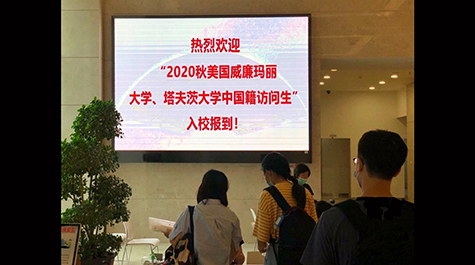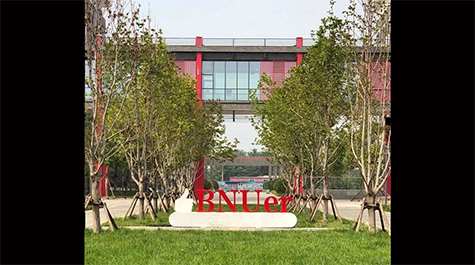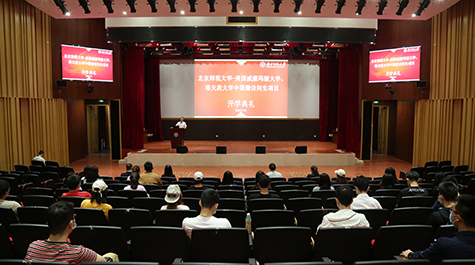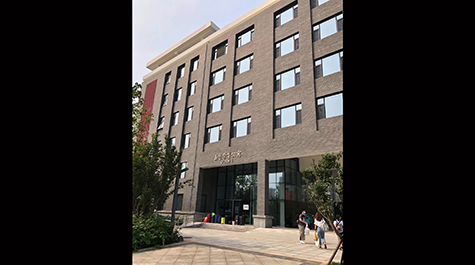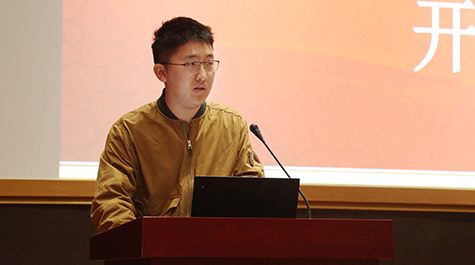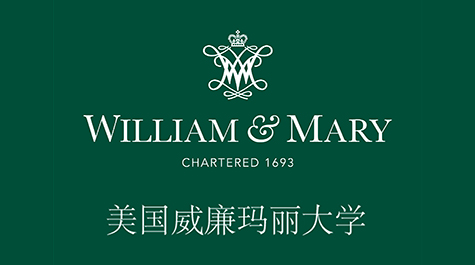Reves manages a quick pivot with a lot of help from their friends — at W&M and abroad
By Kate Hoving
On September 6, thirty-five William & Mary undergraduates began their fall 2020 semester at Beijing Normal University (BNU). When classes ended this past spring, that had not been their plan. In fact, in May, there was no William & Mary Semester at BNU program. Much about the program was out of the ordinary. The application due date for semester programs is usually at least three to six months before the program begins; the application deadline for this program was July 29, less than two months before the start date. But since the onset of COVID-19 and the global pandemic, there was very little that was “as usual” or as planned.
Successful study abroad and international educational programs rely heavily on advance planning, careful preparation, stable infrastructure and consistency. Planning begins up to two years ahead of time.
However, because behind any quick pivot are years of preparation, experience and long-established and nurtured relationships, for these 35 students, the Reves Center made an uncertain and fearful situation a best-case scenario in record time.
Thinking ahead
Last April, most of the university’s focus, by necessity, was on making the campus safe, helping on-campus students get home, finding housing for international students and bringing those studying abroad home safely. But there was another population that Reves needed to think about, and between pandemic restrictions and immigration issues, the path forward was anything but clear.
Molly DeStafney, Associate Director of Global Education Programs, recalls, “In the spring, it became more and more apparent that there was going to be an issue with students returning in the fall.”
Steve Hanson, Vice Provost for International Affairs and Director of the Reves Center, also was concerned about international students not being able to return to the U.S. by fall, and he mobilized all of Reves—the Global Engagement Team (GET), the Global Education Office (GEO), the International Students, Scholars & Programs Office (ISSP), and the William & Mary Confucius Institute (WMCI)—to find a solution for W&M students in China. Each team would bring their special abilities and connections to contribute to the solution.
Identifying and reaching out to the students
The first step was identifying which students were affected and what kinds of options would appeal to them. ISSP was key.
“In the summer, when we knew that many international students could not return to W&M due to visa and travel restrictions, we started working closely with campus partners such as Undergraduate Admissions, GEO, and the Registrar to identify solutions for these students,” says Eva Wong, Director of ISSP. “We sent out a survey to the students, and many indicated they would be interested in keeping their W&M student status by enrolling in ‘in-country local’ study options. We knew then that our partnerships with universities in China could be a good option for our students in China.”
ISSP prepared the list or residents of China and shared it with GEO. “GEO reached out to the students. We worked closely with GEO to make sure that our messaging was consistent and that students were receiving accurate information from both offices.”
Identifying partner institutions
“We in GEO had also been thinking along these lines,” concurs Sylvia Mitterndorfer, Director of GEO, “and quickly agreed that it would be great to approach our longstanding partner institutions – Beijing Normal University (BNU) and University of Electronic Science and Technology of China (UESTC) in Chengdu -- to see if they might be interested and willing to host our students.”
The potential partnership made sense for multiple reasons, even something as basic as the fact that the 12-hour time difference makes any synchronous W&M classes very difficult for students in China.
The next step was to collaborate with the William & Mary Confucius Institute (WMCI). Ying Liu, Associate Director, and Deliang Wang, Chinese Director, immediately agreed to make connections with their partners in China. They also offered to assist in communications, and for many families, the option of communicating in Mandarin has made a tremendous difference in facilitating process.
“In the preparatory stage, we acted as intermediary between the two universities: sending various versions of the contract for BNU to review, negotiating with BNU on the extension of deadlines of recruitment and payment, and sharing information with W&M on dorms, courses, and other logistical matters,” Liu explains.
Both BNU and UESTC expressed interest and willingness to work with Reves to craft a program, but ultimately more students preferred the Beijing location, so BNU was chosen as host institution. Another advantage was that BNU had hosted the summer 2019 program to Beijing as well as winter programs for the past two years.
The process of building a new program with unique challenges
In spite of the unusual circumstances and accelerated timeline, Mitterndorfer had faith in the capability of the GEO staff. “Building programs and managing the entire cycle is what we do so well. Our in-house expertise is tremendous and exceptional. To create this program so quickly required world-class expertise and wonderful partners to make something happen quickly, especially in the middle of a pandemic.”
Mitterndorfer’s first decision was to name one of her most experienced staff members, DeStafney, as program director, advisor and point of contact for students. Destafney, at W&M since 2011, has worked with scholarship programs, the Keio summer program, and all W&M summer programs during her tenure at W&M. Currently, in her role as Associate Director, she oversees the process and administration of all established W&M Programs for Arts & Sciences students (summer and semester), aids in the development of new programming, and continues to manage a portfolio of summer programs, as well as regional advising duties for China, Japan and Singapore, including advising for the outgoing exchanges in those countries. DeStafney traveled to China on a site visit for the 2018 Summer Program in China, and although BNU was not the host institution, she did visit the BNU campus.
As with any study program, the BNU program is a campus-wide collaboration, and the process followed usual paths, including:
- Hanson and GEO worked with BNU colleagues to set the price of the program.
- Mitterndorfer aligned the application process with policies of the International Travel Review Committee (ITRC), coordinating with ITRC member Nick Vasquez, International Travel and Security Manager and member of the Reves GET, well as Pamela Mason, Chief Compliance Officer
- GEO updated other offices and International Studies Advisory Committee (ISAC) about developments with the program
- GEO interfaced with the departments that always play a role in study abroad programs: Dean of Students Office, the Registrar’s Office, Academic Advising, Student Accounts, the Dean of Arts & Sciences Office, and others.
But there were differences from the typical path in addition to the quicker turnaround time.
New challenges; new solutions
Due to the pandemic and the complexity and sensitivity of health and immigration issues, Hanson worked with leadership to ensure that this program aligned with overall goals and took a more active role than usual in helping to determine the parameters of the program.
There was also the challenge of trying to commit to firm deadlines and dates. GEO had to coordinate W&M’s evolving on-campus fall plans to adapt program timelines and ensure students could make informed decisions. This fell mostly to DeStafney, Liu and Mitterndorfer to keep everyone abreast of changing situations and deadlines. Mitterndorfer praises their partners at BNU. “I am very thankful for BNU’s flexibility regarding our summer timeline, giving us several extensions as the W&M fall semester came into clearer focus.”
The BNU program was different in that it was designed for residents of China; other W&M-sponsored programs are generally designed for students who are not necessarily residents of the country.
But the greatest difference is that this is a new type of program for William & Mary. “This is the first time we’ve done this,” notes DeStafney. “The University of Virginia partners with a university in China and has an office there, and Tufts has had a partnership with BNU--and has 70 students there this fall-- but the difference with William & Mary’s program is that our students are full-time BNU students; they’re not in a hybrid program.”
That means that if one of the students wanted to take a W&M course, they would need to seek dual enrollment. As a result, GEO worked with Dean of Undergraduate Studies Janice Zeman and Dean of Students Marjorie Thomas to streamline the approval process.
The value of partners
BNU is not the only partner with which William & Mary is working this fall. Mitterndorfer is quick to express gratitude to Yonsei University, who opened their doors to William & Mary’s international students in South Korea. International students are also enrolled at several other universities in their home countries. Hertford College at Oxford University — one of William & Mary’s sponsored semester partners — is offering their fall semester in-person as well as remotely, allowing even those unable to travel to experience the tutorial system. A few students also successfully petitioned to study abroad through other universities. In all, approximately 50 students are studying abroad this semester, in person or virtually, including the 35 BNU students.
The student experience
The students at BNU this fall are all returning students. “We did not invite transfer students or freshmen; the university felt students should already have a strong identification with William & Mary,” DeStafney explains.
One unexpected reaction DeStafney has noticed is a bit of a culture shock. “This may be the first time these students have been in an educational environment in China for a very long time. Some may have studied abroad for several years. It’s been an adjustment.”
DeStafney describes it as a case of “expecting one thing and getting something else.” In some courses, it may simply be a matter of a difference between Chinese terms and the English terms the students have become accustomed to using and hearing. “It’s home and looks familiar, but in some ways it’s really an alternate universe.”
Liu concurs. “I thought our students would not have any difficulty following the classes taught in their native language. But a few students did have trouble with their classes due to differences in pedagogy and knowledge structure.” She and DeStafney are in constant contact with students as well as the BNU coordinators and faculty, and after a brief period of adjustment, things are now going well.
Liu has noticed another positive outcome. “I think their parents must feel relieved. I heard through the grapevine that when some pictures and information of our BNU program were shared in Chinese parents’ WeChat groups, some parents were quite envious and asked why such a program was not offered for their students at other universities.”
 Skip to main content
Skip to main content

